Lodhi Road in New Delhi is one of the city’s main cultural centres. It is full of enlivening options and has something for almost everyone seeking a break from the mundane life.
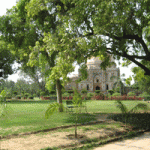 The most famous landmark here, after which the road gets its name, is the Lodi Garden. Laid out in 1936, Lodi Garden is a blissful haven for walkers, picnicker and couples looking for privacy! It was laid out around beautiful tombs and other remnants from the Lodi era. The monuments showcase an unusual variety of
The most famous landmark here, after which the road gets its name, is the Lodi Garden. Laid out in 1936, Lodi Garden is a blissful haven for walkers, picnicker and couples looking for privacy! It was laid out around beautiful tombs and other remnants from the Lodi era. The monuments showcase an unusual variety of 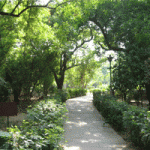 architectural styles ranging from Sayyid and Lodi to Mughal. Lodi garden is a delight not only for those who appreciate history but also for bird-watchers and for fitness enthusiasts who can take advantage of the daily yoga classes and the jogging track that runs around the gardens. There much variety in fauna as well as lotus ponds rose gardens and fountains. Making the most of the abundance of natural beauty here is the Lodi Garden restaurant which successfully creates a lovely ambience.
architectural styles ranging from Sayyid and Lodi to Mughal. Lodi garden is a delight not only for those who appreciate history but also for bird-watchers and for fitness enthusiasts who can take advantage of the daily yoga classes and the jogging track that runs around the gardens. There much variety in fauna as well as lotus ponds rose gardens and fountains. Making the most of the abundance of natural beauty here is the Lodi Garden restaurant which successfully creates a lovely ambience.
The adjacent Max Muller Marg houses the India International Centre which yields great influence on the cultural and intellectual character of Delhi. IIC maintains a non-official and non-aligned character but acts like a catalyst of intellectual and cultural activity throughout the country. The Centre is a combination of three main elements – the Intellectual (in the form of seminars, symposia, lecture and a well-stocked library etc), the Cultural (in the form of recitals, screenings, theatre, exhibitions etc) and the Social (owing to their hostel and catering facilities). Max Muller Marg is also home to the offices of two major international organisations – the World Wildlife Fund and the United Nations Development Program.
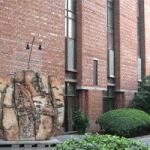 Another major stop on the cultural map of Delhi is the India Habitat Centre, located right around the corner. IHC is a centre of contemporary cultural, economic, business and social events. It was conceived to provide an environment that would help create synergies between individuals and institutions working in diverse habitat related areas. The centre’s building has an interesting design – It has a huge courtyard, surrounded
Another major stop on the cultural map of Delhi is the India Habitat Centre, located right around the corner. IHC is a centre of contemporary cultural, economic, business and social events. It was conceived to provide an environment that would help create synergies between individuals and institutions working in diverse habitat related areas. The centre’s building has an interesting design – It has a huge courtyard, surrounded 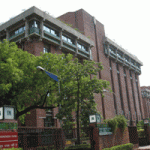 by buildings, which stays cool even in Delhi’s fiery heat owing to blue fabric roofs laid to reflect away excess sunlight. The premise of the centre is beautiful with greenery and the unique art on display. IHC plays host to a number of cultural activities like plays, theatre workshops, film festivals, recitals etc throughout the year and also has a wonderful and reputed art gallery. Restaurants like Eatopia, and the All American Diner attract Delhi-ites by the swarm. Members Only restaurants like Delhi O Delhi, Oriental Octopus and Deck are also coveted.
by buildings, which stays cool even in Delhi’s fiery heat owing to blue fabric roofs laid to reflect away excess sunlight. The premise of the centre is beautiful with greenery and the unique art on display. IHC plays host to a number of cultural activities like plays, theatre workshops, film festivals, recitals etc throughout the year and also has a wonderful and reputed art gallery. Restaurants like Eatopia, and the All American Diner attract Delhi-ites by the swarm. Members Only restaurants like Delhi O Delhi, Oriental Octopus and Deck are also coveted.
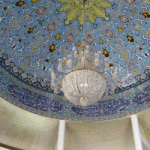 Nearby, the India Islamic Cultural Centre (IICC) serves as a rich centre for cultural exchange. It too hosts plays, poetry/prose recitals, conventions and lectures. However, dance and related forms are not permitted within its premises. The lobby of IICC is beautifully decorated with murals on walls and ceilings. In their attempt to communicate and ward off myths regarding the religion, the walls of IICC is plastered with many eye opening posters.
Nearby, the India Islamic Cultural Centre (IICC) serves as a rich centre for cultural exchange. It too hosts plays, poetry/prose recitals, conventions and lectures. However, dance and related forms are not permitted within its premises. The lobby of IICC is beautifully decorated with murals on walls and ceilings. In their attempt to communicate and ward off myths regarding the religion, the walls of IICC is plastered with many eye opening posters.
Akin to the Islamic Centre, is the Chinmaya Centre, a Hindu non-profit trust that also sits on Lodhi Road and organises the likes of plays, recitals, Hindu rituals like the Bhagwad and meditation.
For those on a quest to satiate their cultural appetite, there are multiple choices of activities to partake in, available throughout the year. Lodhi Road can safely be called the Intellectual Street of New Delhi.
